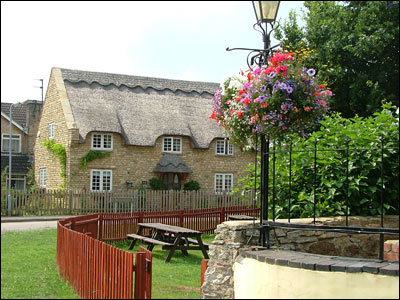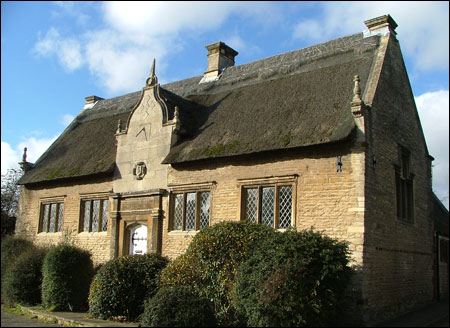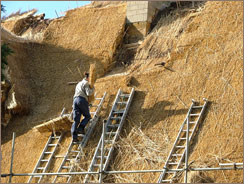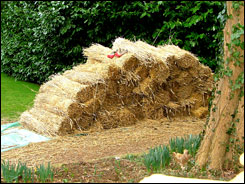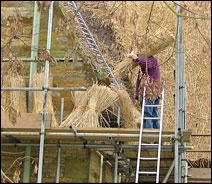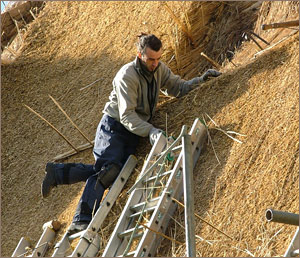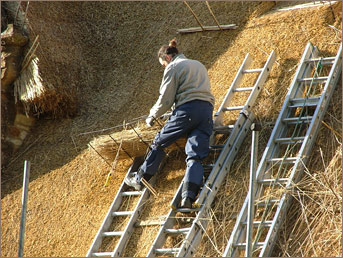| Article and photographs by Leslie Ellison | ||||||||||||||
|
||||||||||||||
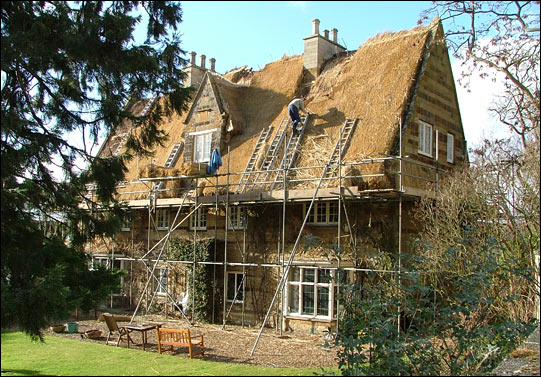 |
||||||||||||||
Whereas the cottages of Weekley and Warkton, on the north side of the A14 link between the M1 and the A1, have retained a goodly proportion of their thatched roofs, Burton Latimer has not. In 1960 only two of the High Street cottages had survived intact and now only the house opposite the Cross remains. (Click to read more on this)
This part of Burton dates mainly from the sixteenth century, although a rebuilding phase in the days of Queen Anne led to the improvement of several substantial houses - made of massive blocks of chocolate coloured ironstone and creamy yellow limestone, sometimes laid in alternating bands sometimes with corners and lintels in the darker stone. Several proudly announce the date of their refurbishment with a date stone in the gable end. And though these buildings no longer are roofed with straw the heavy stones along their roof line show that it is not too long since the roofs were changed to tile and they leave the promise of easy restoration. On the north side of the road the Free Grammar school was built of smooth limestone and sports carved lintels with the minor benefactors’ names cut out in Latin script; and over the door the legend in English proclaims the founder's name and the date of 1622. Thatch has to be replaced every 40 years or so and the old school's roof is starting to show its age, but it is in good order and clearly has had its ridge redone fairly recently. Look at the change of texture between ridge and the roof in the picture below….
On the South Side of Church Street, set back from the road behind a tree filled garden and nestling against the wall of the churchyard, is the ancient Manor House. Here was one of the oldest buildings in Burton and possibly it predated the medieval church of St Mary the Virgin - but probably the first Lord of the Manor’s Hall would have been made from wood, soon after the Norman conquest. That first Hall would almost certainly have had a thatched roof laid on its massive beams. It was rebuilt c1704 and from the start it will have been under thatch. In February of 2006, not long after the house’s 300th anniversary, the thatch is being renewed. The work is being carried out by a three-man team of local men headed by Russell Fox. Russell Fox originally lived in Birmingham but he got interested in the skill of thatching about 26 years ago. He operates from Abington Avenue, Northampton. The Yellow Pages Directory lists eleven firms of thatchers but only eight of these live in the County. Neatly trimmed sheaves of wheat straw are stacked in the front garden under a spreading tree. And as I stood observing the scene from the churchyard wall, a man descended from the scaffolding and picked out a few bundles from the stack. He was warmly clad in a thick plaid shirt and had a woolly hat pulled over his ears and I greeted him. He came over to take a short break. I asked if he was Russell Fox and he said no, his name was Barry Richard, Mr Fox was away attending to some family business. Barry has worked as a thatcher for 23 years - before that he was a long distance lorry driver but he learned his present job in his late twenties and though it is hard work it is a great way to earn a living. I said it was a cold way, on a day like this “ Well it is on this north side, but over on the sunny side you will see my colleague is working in a thin shirt - the sun reflects back from the fresh straw and that keeps you warm. And this side would be the best place on a hot day, though“ I resisted saying Barry had drawn the short straw in his choice of side this time. And this prompted me to ask where the straw came from.
“The straw is wheat straw, and this comes up from Somerset” “Is that because it is better down there?” “Yes, but it is organically grown and is grown specifically for thatching - Wheat grown for the grain is bred to have short stalks that do not lodge in the wind; which makes it easier to harvest. We need longer straw and more traditional cutting methods” I pointed at a smaller stack next to the wheat straw. It was clearly thin slivers of wood, each about 60 cms long. “And obviously the wheat is fixed down with those strips of - chestnut, is it?” “Hazel. They are double ended spars. We get that from wherever they still coppice the hazel. This makes the branches long, straight and pliable.” He picked out one of the slivers and bent it at the middle, at the same time giving it a twist so that the wood split along the grain for a few centimetres. When he let go he was holding something like a big paper clip. “ I suppose chestnut would do, but Coppicing of large trees is dying out, so its still easier to find young hazel. Hazel trees do not grow to a great age and young growth is still found in hedged areas in Southern England.” Asked whether its shorter life cycle didn’t mean that hazel rotted easily, Barry Richard replied that hazel lasts about ten to twelve years - which does not matter if the thatch has been put up correctly and the packed straw has bedded together; but when exposed to the elements it becomes brittle and eventually rots, so the ridges on thatched houses are best repaired within twenty years. A full renewal is needed after thirty five or forty years. “The Hazel spars we are taking out from this roof at Burton Latimer are over 35 years old and are still sound. The biggest problem in another forty years will be finding trained thatchers - out of all the thatchers I know, not one is under 36.” I pointed to the list from the Yellow Pages and said: “So from this list of entries, if they each represent a team of three or so, there are only about 24 people who can pass on their skills…..” Barry interrupted me - “Less than that, Paul Reading and Oldfield work together, and Costello is on his own, so that cuts your estimate down to well below twenty.” After Mr Richard had climbed back onto the roof of the Manor House, I made sure I took several photographs from as many angles as possible. For, if it takes three fit, well trained men over four weeks to replace the thatch on a large roof now; and bad weather means they can work for only forty weeks a year - then when Burton Latimer Manor House needs it thatch replaced again in 2050 a problem looms. There’ll be many other cottages in the Eastern shires vying for the attentions of the even fewer remaining skilled thatchers still plying their trade. And will those few still get good long wheat straw? or freshly coppiced hazel?
|
||||||||||||||
